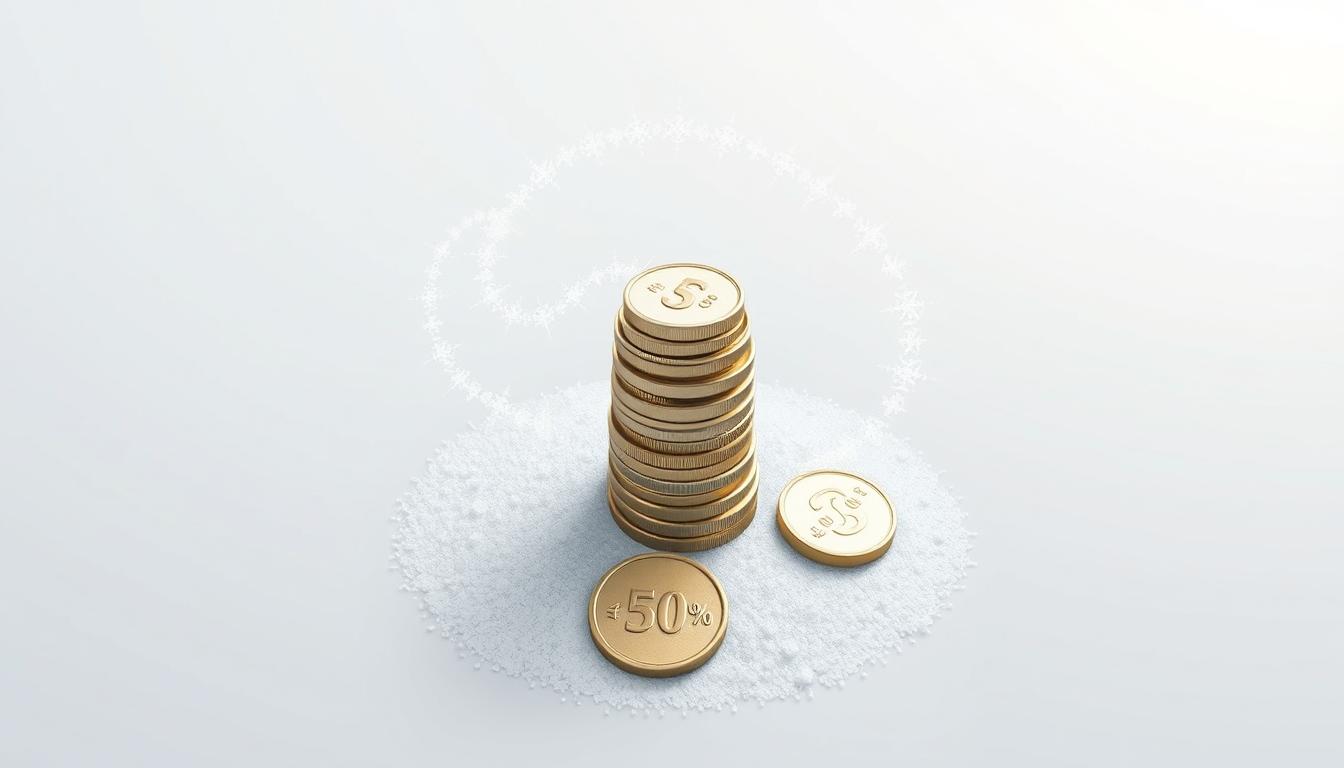Struggling with debt can be overwhelming, but there are effective strategies to regain control of your finances. One such approach is the debt snowball method, a straightforward technique that has helped countless individuals become debt-free.
This debt repayment strategy involves prioritizing your debts, starting with the smallest balance first. By doing so, you’ll experience a sense of accomplishment as you quickly eliminate smaller debts, freeing up more money in your budget to tackle the larger ones.
By implementing the debt snowball method, you’ll not only simplify your finances but also gain momentum in your journey to becoming debt-free.
Key Takeaways
- Understand the debt snowball method and its benefits
- Learn how to prioritize your debts effectively
- Discover how to create a debt repayment plan that works for you
- Gain insights into simplifying your finances and staying on track
- Achieve a debt-free life with a clear strategy
Understanding the Debt Burden in America
The debt burden in America has reached alarming levels, affecting millions of households. The prevalence of debt is a critical issue that impacts not only the economy but also the well-being of individuals and families.
Current Debt Statistics in the United States
The current debt statistics in the United States paint a concerning picture. As of recent data, the total household debt has surpassed $14 trillion, with credit card debt alone exceeding $930 billion. The average household debt per person is over $38,000, not including mortgage debt.
| Type of Debt | Total Amount ($ billion) | Percentage of Total Debt |
|---|---|---|
| Mortgage Debt | 10,500 | 73% |
| Credit Card Debt | 930 | 6.5% |
| Student Loans | 1,700 | 12% |
| Auto Loans | 1,300 | 9% |
The Psychological Impact of Carrying Debt
Carrying debt has a significant psychological impact on individuals, leading to stress, anxiety, and depression. The weight of debt can affect mental health, relationships, and overall quality of life. The constant pressure to make payments can be overwhelming, making it essential to find effective debt repayment strategies.

What is the Debt Snowball Method?
The debt snowball method is not just another debt repayment strategy; it’s a comprehensive plan that addresses the psychological aspect of debt. This method has been widely adopted for its simplicity and effectiveness in helping individuals become debt-free.

Origin and Philosophy Behind the Method
The debt snowball method was popularized by financial expert Dave Ramsey. The philosophy behind this method is rooted in the idea that by quickly eliminating smaller debts, individuals can achieve a sense of accomplishment and momentum in their debt repayment journey. This approach is grounded in behavioral economics, which suggests that small wins can significantly boost motivation.
How It Differs from Other Debt Repayment Strategies
Unlike other debt repayment strategies that focus solely on interest rates, the debt snowball method prioritizes debts based on their balance, from smallest to largest. This approach can be compared to other strategies in the following table:
| Debt Repayment Strategy | Priority | Benefit |
|---|---|---|
| Debt Snowball Method | Smallest balance first | Quick wins and psychological boost |
| Debt Avalanche Method | Highest interest rate first | Potential savings on interest |
By understanding the differences between these strategies, individuals can choose the approach that best suits their financial situation and personal preferences.
The Psychology of the Snowball Method
The snowball method’s success lies not just in its mathematical structure, but in its psychological impact. By focusing on paying off smaller debts first, individuals experience a series of quick wins that build momentum and motivation.
Behavioral Economics and Small Wins
The debt snowball method leverages principles from behavioral economics, particularly the concept of small wins. When individuals achieve small victories, such as paying off a credit card or a personal loan, it triggers a positive feedback loop. This encourages them to continue their debt repayment journey. The method capitalizes on the psychological preference for immediate gratification, making the process more engaging and motivating.
Motivation and Momentum in Debt Repayment
As each debt is paid off, the money available for debt repayment increases, creating a snowball effect. This not only accelerates the debt repayment process but also boosts motivation. The psychological impact of seeing debts disappear one by one cannot be overstated. It fosters a sense of accomplishment and reinforces the behavior needed to become debt-free.
| Psychological Factor | Impact on Debt Repayment |
|---|---|
| Small Wins | Boosts motivation and encourages continued debt repayment |
| Momentum | Accelerates the debt repayment process as more funds become available |
| Positive Feedback Loop | Reinforces debt repayment behavior, leading to sustained progress |
By understanding and leveraging these psychological aspects, the debt snowball method provides a powerful framework for achieving financial freedom. It’s not just about eliminating debt; it’s about creating a mindset that supports long-term financial health.
How to Pay Off Debt Faster Using the Snowball Method
Implementing the debt snowball method requires a simple yet effective strategy. This approach involves several key steps that help individuals pay off their debts efficiently.
Step 1: List All Your Debts from Smallest to Largest
The first step is to list all your debts, starting with the smallest balance and moving to the largest. This list will be the foundation of your debt repayment plan. Prioritizing the smallest debt first allows for quick wins, which can be motivating.
Step 2: Make Minimum Payments on All Debts
While focusing on the smallest debt, make minimum payments on all other debts. This ensures that you’re not accumulating additional late fees or penalties. Discipline is key in this step to keep your debt repayment on track.
Step 3: Put Extra Money Toward the Smallest Debt
Any extra funds available should be put towards the smallest debt. This could come from cutting back on expenses, selling items you no longer need, or allocating a portion of your income. Accelerating the payment of the smallest debt will help you pay it off faster.
Step 4: Celebrate Paying Off Each Debt
Celebrating each debt you pay off is crucial for maintaining motivation. Acknowledging your progress helps to keep you engaged in the debt repayment process. After paying off the smallest debt, move to the next smallest, and continue the process until you’re debt-free.
Here’s an example of how the debt snowball method works in practice:
| Debt | Balance | Minimum Payment |
|---|---|---|
| Credit Card | $500 | $25 |
| Car Loan | $10,000 | $300 |
| Student Loan | $20,000 | $100 |
By following these steps and staying committed, you can effectively pay off your debts using the snowball method. This structured approach helps in creating a clear debt repayment plan, making it easier to achieve financial freedom.
Creating Your Debt Snowball Plan
Developing a debt snowball plan involves several key steps that help you systematically pay off your debts. This process begins with gathering your financial information, followed by setting up a debt priority list, and finally, calculating your debt-free date.
Gathering Your Financial Information
To start creating your debt snowball plan, you need to gather all relevant financial information. This includes collecting statements and account details for all your debts.
Collecting Statements and Account Details
Collect all your debt statements, including credit card bills, loan documents, and other debt-related paperwork. Having these documents handy will help you understand the scope of your debt.
Identifying Interest Rates and Terms
Identify the interest rates and terms associated with each debt. This information is crucial for understanding the total amount you owe and the cost of carrying each debt.
Setting Up Your Debt Priority List
Once you have gathered all your financial information, the next step is to set up your debt priority list. List all your debts from smallest to largest, as per the snowball method.
| Debt Type | Balance | Interest Rate |
|---|---|---|
| Credit Card | $2,000 | 18% |
| Car Loan | $15,000 | 6% |
| Student Loan | $30,000 | 4% |
Calculating Your Debt-Free Date
To calculate your debt-free date, you’ll need to determine how much you can realistically pay each month towards your debt. Using a debt repayment calculator or spreadsheet can simplify this process.
Finding Extra Money to Accelerate Your Snowball
Accelerating your debt repayment journey requires more than just a plan; it demands a strategic approach to finding extra money. To effectively accelerate your debt snowball, you need to identify areas where you can cut back, earn more, and utilize resources you already have.
Reducing Monthly Expenses
One of the most straightforward ways to find extra money is by reducing your monthly expenses. Start by reviewing your budget to identify areas where you can cut back without significantly impacting your quality of life. Consider negotiating bills with service providers, such as your cable or internet company, to secure better rates. Additionally, look for ways to save on everyday expenses, like planning meals and using coupons for grocery shopping.
Increasing Your Income
Increasing your income can significantly accelerate your debt repayment. Explore side hustles that fit your skills and schedule, such as freelancing, tutoring, or selling handmade products. You can also consider asking for a raise at your current job, especially if you’ve taken on additional responsibilities. Another option is to take on a part-time job to supplement your income.
Selling Unused Items
Selling unused or unwanted items is another effective way to generate extra money for debt repayment. Go through your home and gather items you no longer need or use, and sell them through online marketplaces, garage sales, or local consignment shops. This not only declutters your living space but also puts cash directly towards your debt.
Common Challenges and How to Overcome Them
Successfully paying off debt using the snowball method requires perseverance and strategies to overcome common hurdles. As you progress on your debt repayment journey, you may encounter unexpected expenses, dwindling motivation, and the complexities of handling high-interest debts.
Dealing with Unexpected Expenses
Unexpected expenses can derail your debt repayment plan. To mitigate this, it’s crucial to build an emergency fund. Even a small, initial fund can help you avoid going further into debt when unexpected expenses arise. Consider setting aside a portion of your income each month in a readily accessible savings account.
Staying Motivated During the Process
Staying motivated is key to completing your debt repayment journey. Celebrate each debt you pay off, no matter how small. This will help you stay encouraged and see the progress you’re making. Additionally, consider sharing your goals with a trusted friend or family member to increase your accountability.
Handling High-Interest Debts Within the Snowball Method
The debt snowball method prioritizes debts based on their balance, not interest rate. However, if you have a debt with an exceptionally high interest rate, you might consider paying it off more aggressively. Here’s a comparison:
| Debt Type | Balance | Interest Rate |
|---|---|---|
| Credit Card | $2,000 | 20% |
| Car Loan | $10,000 | 6% |
| Student Loan | $30,000 | 4% |
In conclusion, while the debt snowball method provides a structured approach to debt repayment, being aware of and prepared for common challenges can significantly enhance your success.
Snowball Method vs. Avalanche Method: Which is Right for You?
When it comes to paying off debt, two popular strategies often come into play: the snowball method and the avalanche method. Understanding the differences between these two approaches can help you decide which one is best suited for your financial situation.
Understanding the Avalanche Method
The avalanche method involves paying off debts in order of their interest rates, starting with the highest. This approach can save you money on interest over time, making it an attractive option for those with high-interest debts.
Mathematical Differences Between Methods
The primary difference between the snowball and avalanche methods lies in their mathematical approach. The snowball method prioritizes debts by balance, from smallest to largest, while the avalanche method prioritizes by interest rate, from highest to lowest.
| Method | Priority | Potential Savings |
|---|---|---|
| Snowball | Smallest balance first | Less interest saved |
| Avalanche | Highest interest rate first | More interest saved |
When to Choose Snowball Over Avalanche
The snowball method can be more effective for individuals who need quick wins to stay motivated. By paying off smaller debts first, you can achieve a sense of accomplishment and momentum.
Ultimately, the choice between the snowball and avalanche methods depends on your personal financial situation and psychological needs.
Real Success Stories: The Snowball Method in Action
Individuals from various backgrounds have achieved debt freedom through the snowball method. This approach has been instrumental in helping people regain control over their finances and start anew. The following case studies illustrate the effectiveness of this method in different scenarios.
Eliminating $30,000 in Debt
One notable success story is that of Sarah, who managed to eliminate $30,000 in debt using the snowball method. By prioritizing her smallest debts first and making minimum payments on the rest, she was able to pay off her debts one by one. Within 18 months, Sarah was debt-free, having paid off her credit cards, personal loans, and mortgage arrears.
From Multiple Debts to Financial Freedom
Another inspiring example is John, who had accumulated multiple debts totaling $20,000. By applying the debt snowball method, he was able to consolidate his efforts and focus on one debt at a time. John’s disciplined approach allowed him to pay off his debts in just over two years, freeing him from the burden of debt and enabling him to start saving for the future.
Tools and Resources to Support Your Debt Snowball Journey
Embarking on a debt snowball journey requires the right tools and resources to stay on track. With numerous options available, individuals can choose the tools that best fit their financial needs and preferences.
Debt Payoff Apps and Calculators
Debt payoff apps and calculators are invaluable resources for managing your debt snowball plan. Apps like Qapital and Digit help track expenses and savings, while calculators on websites such as NerdWallet and Bankrate enable you to determine the most effective debt repayment strategy.
- Qapital: Helps in tracking expenses and setting savings goals.
- Digit: Automates savings by transferring small amounts from checking to savings.
- NerdWallet Debt Calculator: Provides a comprehensive overview of your debt and suggests repayment plans.
- Bankrate Debt Repayment Calculator: Calculates how long it will take to pay off debt based on different repayment strategies.
Budgeting Tools for Debt Repayment
Effective budgeting is crucial for a successful debt snowball plan. Tools like Mint and You Need a Budget (YNAB) offer comprehensive budgeting solutions that help track income and expenses, making it easier to allocate funds towards debt repayment.
Books and Courses on the Snowball Method
For those who prefer learning through reading or taking courses, there are numerous resources available. Books like “The Total Money Makeover” by Dave Ramsey provide in-depth guidance on using the debt snowball method, while online courses on platforms like Coursera and Udemy offer structured financial education.
- “The Total Money Makeover” by Dave Ramsey: A comprehensive guide to debt reduction.
- Coursera Financial Planning Specialization: Offers a deep dive into personal finance and debt management.
Life After Debt: Maintaining Financial Freedom
Maintaining financial freedom after becoming debt-free involves several key strategies. It’s not just about having paid off your debts; it’s about building a sustainable financial future.
Building an Emergency Fund
One crucial step is to build an emergency fund. This fund acts as a safety net, covering unexpected expenses and preventing you from falling back into debt. Aim to save three to six months’ worth of living expenses in a readily accessible savings account.
Investing for the Future
Investing for the future is another vital aspect of maintaining financial freedom. Consider contributing to retirement accounts or other investment vehicles that align with your financial goals. This not only secures your financial future but also helps you build wealth over time.
Avoiding Debt Relapse
To avoid debt relapse, it’s essential to monitor your spending habits and maintain a budget. Regularly review your financial situation to identify areas for improvement and make adjustments as needed. By staying vigilant, you can enjoy the benefits of being debt-free without the risk of falling back into financial trouble.
Conclusion: Your Path to Financial Freedom
Embracing the debt snowball method can be a transformative step on your path to financial freedom. By understanding the psychology behind this approach and following the straightforward steps outlined, you can break free from the burden of debt and start building a more secure financial future.
As you conclude your debt snowball journey, you’ll not only have eliminated your debts but also gained valuable insights into managing your finances effectively. The conclusion on debt snowball method is clear: it’s a powerful tool for achieving financial stability.
Now, it’s time to take control of your financial destiny. With persistence and the right strategy, you’ll be well on your path to financial freedom, ready to tackle new challenges and seize opportunities with confidence.
FAQ
What is the debt snowball method?
The debt snowball method is a debt reduction strategy that involves paying off debts in a specific order, starting with the smallest balance first, while making minimum payments on other debts.
How does the debt snowball method work?
The debt snowball method works by listing all your debts from smallest to largest, making minimum payments on all debts except the smallest one, which you pay off as aggressively as possible. Once the smallest debt is paid off, you move on to the next smallest debt, and so on.
What are the benefits of using the debt snowball method?
The benefits of using the debt snowball method include quick wins, which can help build momentum and motivation, as well as a clear plan for becoming debt-free. This method can also help reduce stress and anxiety associated with debt.
How do I create a debt snowball plan?
To create a debt snowball plan, you need to gather your financial information, list all your debts from smallest to largest, and determine how much you can afford to pay each month towards your debt. You can use debt snowball calculators or budgeting tools to help you stay on track.
What if I have high-interest debts? Should I still use the debt snowball method?
While the debt snowball method focuses on paying off debts with the smallest balances first, you may want to consider alternative strategies, such as the debt avalanche method, if you have debts with significantly high interest rates. However, the debt snowball method can still be effective if you need the psychological boost of quick wins.
How can I stay motivated during the debt repayment process?
To stay motivated, you can celebrate each debt you pay off, track your progress, and remind yourself of your goals. You can also use debt repayment apps, join a debt support group, or work with a financial advisor to help you stay on track.
What are some common challenges when using the debt snowball method, and how can I overcome them?
Common challenges include dealing with unexpected expenses, staying motivated, and handling high-interest debts. To overcome these challenges, you can build an emergency fund, find ways to reduce expenses and increase income, and consider alternative debt repayment strategies.
Can I use the debt snowball method if I have multiple debts with different interest rates?
Yes, you can still use the debt snowball method even if you have multiple debts with different interest rates. However, you may want to consider the debt avalanche method if the interest rates vary significantly, as it may save you more money in interest over time.
Are there any tools or resources that can help me with the debt snowball method?
Yes, there are many tools and resources available, including debt snowball calculators, budgeting apps, and financial education resources. You can also consider working with a financial advisor or joining a debt support group to help you stay on track.
What happens after I’ve paid off all my debts using the debt snowball method?
After becoming debt-free, you can focus on building an emergency fund, investing for the future, and maintaining good financial habits to avoid debt relapse. You can also consider other long-term financial goals, such as saving for retirement or a down payment on a house.

